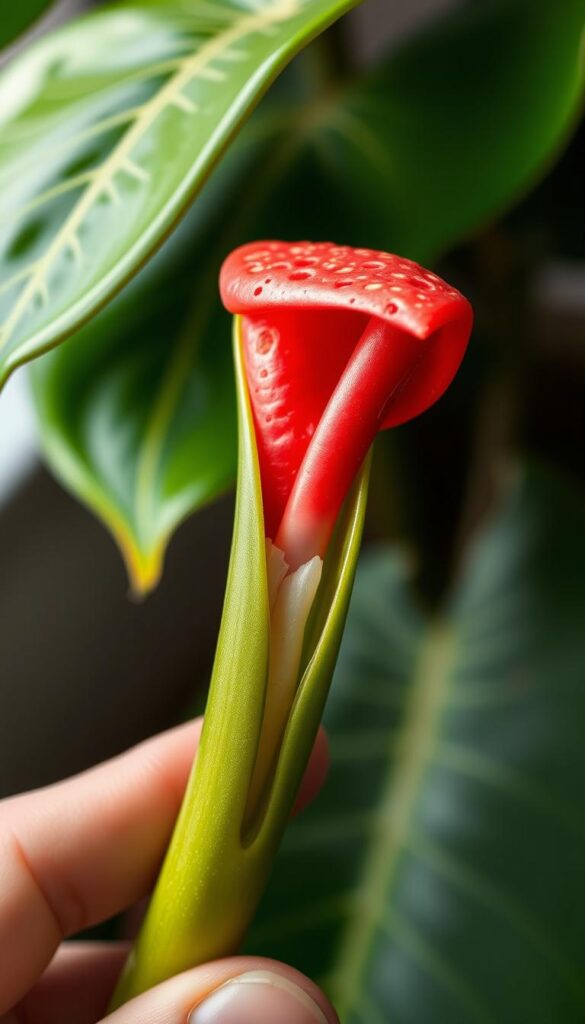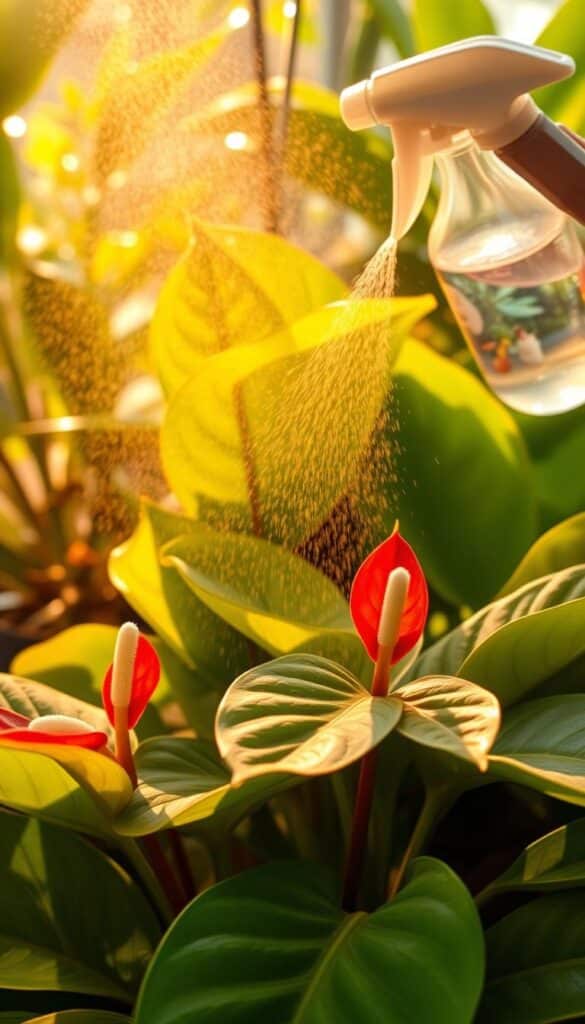Have you ever been captivated by the stunning beauty of Anthurium plants? These tropical gems are not only a delight to the eyes but also a joy to grow. Propagating Anthurium plants is a rewarding way to expand your collection and share these lovely plants with friends and family.
In this guide, I’ll walk you through the process of Anthurium propagation, breaking it down into simple, easy-to-follow sections. Whether you’re a seasoned gardener or just starting out, this guide will provide you with the knowledge you need to successfully grow new plants from your existing ones.
Learning how to propagate Anthurium plants can save you money and help you create more beautiful houseplants. Understanding the right methods and care is crucial for success. With this guide, you’ll gain the confidence to propagate Anthurium plants like a pro!
Introduction to My Anthurium Propagation Journey
My adventure with Anthurium plants began when I received a beautiful plant as a gift. Fascinated by their elegant blooms and lush leaves, I soon wanted more. This curiosity led me to explore propagation, and I quickly discovered the joy of growing new plants from cuttings and divisions.
Why I Love Propagating Anthuriums
There’s something special about nurturing a small cutting into a thriving plant. I enjoy the process of rooting stems and watching new growth emerge. Each successful propagation feels like an accomplishment, and it’s rewarding to share these plants with friends and family.
The Benefits of Growing Your Own Plants
Growing your own plants offers many rewards. Not only does it add beauty to your home, but it also provides a sense of satisfaction. Understanding the right conditions, like proper light and water, ensures healthy growth. Every step, from taking a cutting to nurturing new growth, is a learning experience.
| Aspect | Growing Your Own | Buying Plants |
|---|---|---|
| Cost | Cost-effective | Higher initial cost |
| Customization | Control over plant selection | Limited to available stock |
| Satisfaction | Personal growth experience | Instant gratification |
| Learning | Opportunity to learn about plant care | No learning involved |
Every step in propagation, from cutting to nurturing, has been a learning experience. It’s about patience and care, ensuring the right conditions for growth. This journey has taught me much about plant care and the importance of light and time commitment.
Gathering the Right Tools and Materials
Before diving into the world of plant propagation, it’s essential to have the right tools and materials ready. This ensures your cutting has the best chance to root and grow into a healthy plant.
Essential Equipment for Propagation
To start, you’ll need a few must-have items:
- Pruning Shears: These are crucial for taking clean cuts on your stem cuttings.
- Well-Draining Potting Mix: A mix with perlite ensures proper drainage, preventing waterlogged soil.
- Small Pots or Containers: These will house your cuttings as they develop roots.
Sterilizing your pruning shears is a must to avoid transferring diseases to your plant.
Optional Items to Boost Success
While not necessary, these extras can enhance your propagation success:
- Rooting Hormone: This stimulates root growth, giving your cutting a head start.
- Moisture Meter: Helps monitor soil moisture levels, ensuring the mix stays moist but not soggy.
Using these optional items can significantly improve your chances of successful propagation.
Choosing a Healthy Anthurium for Propagation
Starting with a healthy Anthurium plant is the first step toward successful propagation. A vigorous mother plant ensures that your cuttings or divisions have the best chance to thrive.
Selecting a Vigorous Mother Plant
A healthy Anthurium plant is easy to spot. Look for lush, vibrant foliage and sturdy stems. The leaves should be a deep green color, and the stems should be firm, not brittle or soft.
Avoid plants with any signs of rot or damage. Check the leaves and stems for soft spots or discoloration, which could indicate disease or pests. A healthy plant will have robust growth and a balanced structure.
Before taking a cutting, ensure your plant is in optimal condition. Provide bright, indirect light and keep the soil consistently moist but not waterlogged. A well-cared-for plant will produce stronger cuttings and better results.
Remember, a healthy mother plant is the foundation of successful propagation. Whether you’re using stem cuttings or division, a strong, thriving plant will give you the best outcomes.
How to Propagate Anthurium: Essential Techniques
Now that we’ve covered the basics, let’s dive into the actual techniques for propagating Anthurium plants. These methods are straightforward and yield great results when done correctly.
Stem Cuttings: My Personal Method
My go-to method for propagating Anthurium plants involves using stem cuttings. Here’s how I do it:
- Choose a healthy stem with at least two nodes.
- Cut a 4-6 inch section using clean pruning shears at a 45-degree angle.
- Remove lower leaves, leaving only a few at the top.
- Dip the cut end in rooting hormone to stimulate root growth.
- Plant the cutting in well-draining soil, ensuring the node is buried.
Keep the soil moist but not soggy. Roots should develop within 4-6 weeks.

Root Division and Seed Germination Insights
For a different approach, root division is effective. Gently separate the roots of a mature plant and pot each section. This method works best when the plant is pot-bound.
Seed germination is another option, though it’s less common. Collect seeds after the plant flowers, then sow them on moist sphagnum moss. Keep the environment humid until germination, which can take 3-6 months.
Setting Up the Ideal Environment for New Growth
Creating the right environment is crucial for the successful growth of your new Anthurium plants. Proper light, temperature, and soil conditions will help your cuttings thrive.
Providing Bright, Indirect Light and Warm Temperatures
Anthurium plants prefer bright, indirect light. Direct sunlight can be too intense and may cause the leaves to become discolored. The ideal temperature for growth is between 70°F and 90°F (21°C to 32°C). Avoid placing plants near drafts or extreme temperature fluctuations.
Maintaining Consistent Moisture and Proper Soil
Keep the soil consistently moist but not waterlogged. Use a high-quality potting mix designed for tropical plants to ensure proper drainage. It’s also beneficial to maintain a humid environment, especially during the rooting phase, to support healthy growth.
| Factor | Optimal Conditions | Tips |
|---|---|---|
| Light | Bright, indirect light | Place near an east- or west-facing window |
| Temperature | 70°F – 90°F | Avoid drafts and extreme changes |
| Soil | Well-draining potting mix | Check moisture daily |
| Humidity | 50-70% | Use a humidifier if necessary |
By carefully controlling these environmental factors, you’ll give your Anthurium cuttings the best chance to develop strong roots and healthy growth.
Boosting Success with Rooting Hormones and Humidity
Discover how rooting hormones and humidity can significantly enhance your plant propagation success. These simple yet effective techniques can make a big difference in the growth of your new plants.
The Role of Rooting Hormone in Faster Growth
Rooting hormone is a game-changer for plant propagation. It stimulates root development, helping your cuttings establish a strong root system faster. I’ve personally seen cuttings root in just a few weeks when using a rooting hormone. Simply dip the cut end of your stem into the hormone before planting for best results.
Creating a High-Humidity Space for New Roots
High humidity is crucial for new roots to develop. You can create a humid environment by covering the pot with a clear plastic bag or using a humidity tray. Maintain a temperature between 70°F and 90°F for optimal root growth. This balance of temperature and humidity will help your cuttings thrive and develop into robust plants.

By incorporating rooting hormones and maintaining high humidity, you’ll give your plants the best chance to succeed. These extra steps are well worth the effort for healthy, vigorous growth.
Troubleshooting Common Propagation Challenges
Even with the best care, challenges like rot and pests can arise during propagation. These issues can hinder growth, but with the right approach, they can be managed effectively.
Preventing Rot and Managing Pests
Fungal rot is a common problem, often caused by overwatering. To prevent this, ensure your potting mix drains well and avoid waterlogging. If you notice soft, discolored areas, treat them promptly with a fungicide and improve air circulation.
Pests like spider mites or mealybugs can also appear. Inspect your plants regularly, especially the underside of leaves. Use neem oil or insecticidal soap to control infestations early on.
| Factor | Optimal Conditions | Tips |
|---|---|---|
| Light | Bright, indirect light | Avoid direct sunlight |
| Water | Moist but not soggy | Check soil daily |
| Soil | Well-draining mix | Add perlite for drainage |
By addressing these challenges promptly, you can ensure healthy growth and successful propagation. Regular monitoring and proper care will help you overcome any setbacks.
Final Reflections on Expanding Your Anthurium Collection
Reflecting on my journey with Anthurium plants, I’m thrilled to see how far I’ve come. From the first cutting to nurturing each new plant, every step has been a learning experience. It’s amazing how much joy comes from watching a small stem develop into a beautiful, thriving plant.
Celebrating each new addition to my collection reminds me of the importance of proper care. Consistent light, water, and soil conditions lay the groundwork for success. Overcoming challenges like rot and pests has taught me the value of vigilance and the right techniques.
I encourage you to share your own propagation stories and tips. Building a tropical plant collection is a rewarding hobby that brings beauty and life to any home. With patience and the right methods, anyone can enjoy the elegance of Anthurium plants for years to come.
